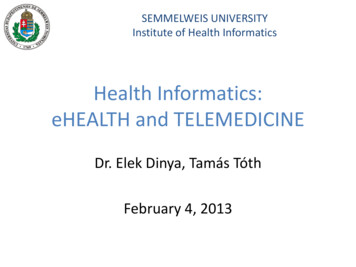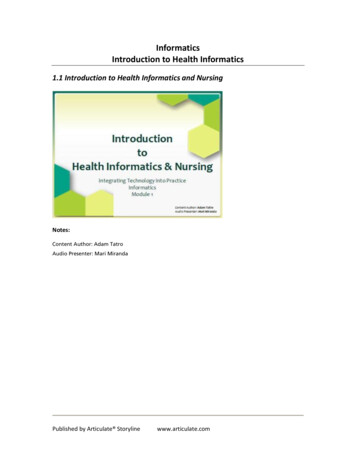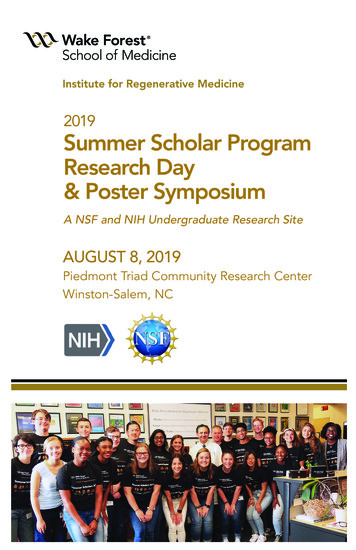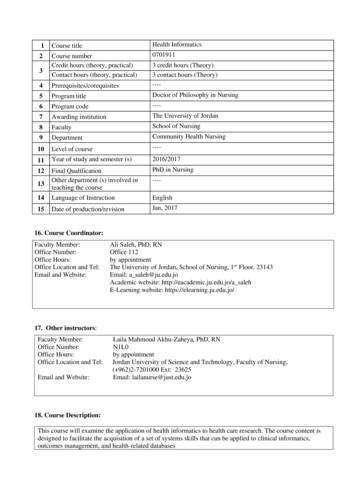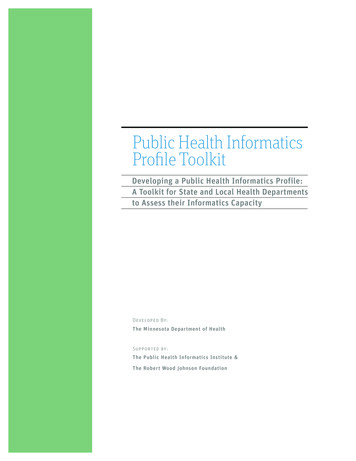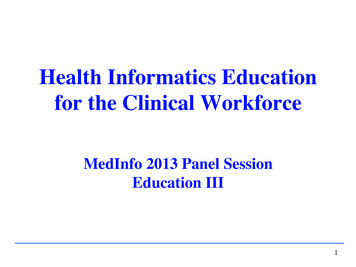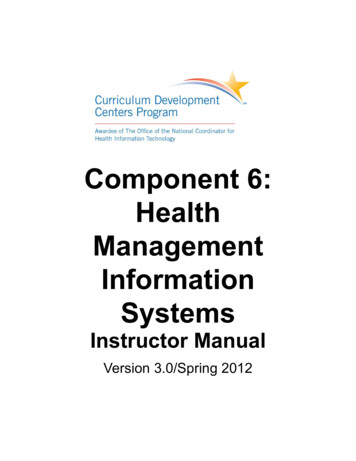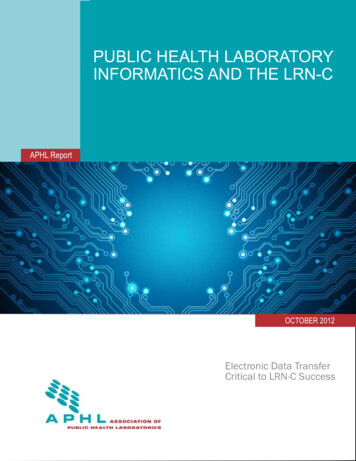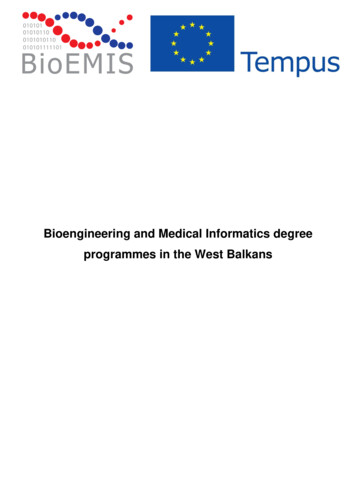
Transcription
Bioengineering and Medical Informatics degreeprogrammes in the West Balkans
Executive SummaryBioEMIS is a European Commission Tempus project to develop new study programmes inBioengineering and Medical Informatics at universities in the West Balkans. This reportsummarises the work undertaken in work package 1.2 to analysis the Bioengineering andMedical Informatics degree programmes at universities in the West Balkans.2
AcknowledgmentsThis study is supported by TEMPUS project 530417-TEMPUS-1-2012-1-UK-TEMPUSJPCR.3
Table of Contents1.Introduction . 52.Bosnia and Herzegovina . 53.4.2.1Introduction . 52.2Faculties of medicine/health studies/pharmacy. . 62.3Faculties of mechanical engineering/electrical engineering/computer sciences . 6Montenegro . 93.1State of BE and MI education in Montenegro . 93.2Development of the rehabilitation engineering .103.2Development of Medical Robotics and Biomechanical systems .103.3Development of MI, E-Health and Telemedicine.103.4Development of Medical Electronics and Medical Instrumentation .113.5Educational modules and courses from fields of BE and MI .123.6Summary on BE and MI educational modules in Montenegro and conclusions .12Serbia.144.1Introduction .144.2Center of Interdisciplinary and Multidisciplinary Studies and Research .154.3State of the Art .164.4The Latest Developments .164
1.IntroductionBioEMIS is a European Commission Tempus project to develop new study programmes inBioengineering and Medical Informatics (BE&MI) at universities in the West Balkans (WB).This report summarises the work undertaken in work package 1.2 to analysis the currentBioengineering and Medical Informatics degree programmes at universities in the WB,namely in Bosnia and Herzegovina, Montenegro and Serbia2.Bosnia and Herzegovina2.1IntroductionIn Bosnia and Herzegovina there is no study program in biomedical engineering or medicalinformatics. Also, an organized society on biomedical/biological engineering has not yet beenestablished. Analysis of study programs and courses in biomedical engineering and medicalinformatics in Bosnia and Herzegovina included 20 public faculties at 8 universities: 5faculties of medicine, 4 faculties of health studies, 1 faculty of pharmacy, 6 faculties ofmechanical engineering, 2 faculties of electrical engineering, 2 faculties of computersciences (Table 1).Table 1. Analyzed faculties in Bosnia and Webpageof Faculty of Health anical http://www.mef.unsa.ba/EngineeringFaculty of MedicineUniversityof FacultyEast Sarajevoofhttp://www.mf.unsa.baElectrical anical http://www.maf1.unssa.rs.baEngineeringFaculty of MedicineBanja LukaUniversityBanja Lukaof Facultyofhttp://www.mf-foca.rs.baElectrical http://etf.unibl.orgEngineeringFacultyofMechanical http://mf.unibl.orgEngineeringFaculty of MedicineMostarUniversityMostarof Faculty of Health StudiesFaculty of e-mo.bahttp://www.mefmo.baMechanical www.fsr.baEngineering and Computing5
Džemal Bijedić FacultyUniversityofInformation http://www.fit.baTechnologiesFacultyofMechanical laof Faculty of cal http://www.mf.untz.baEngineeringFaculty of MedicineZenicaUniversityhttp://www.medf.untz.baof Faculty of Healthhttp://www.zf.unze.baof College of Nursing yBihaćFacultyofTechnical http://www.tfb.baEngineering2.2Faculties of medicine/health studies/pharmacy.In the analyzed faculties there is no study program in biomedical engineering/medicalinformatics leading to a university degree. In all of these faculties there are someundergraduate/graduate/postgraduate courses, which are necessary for education inbiomedicine. Most of them are mandatory for individual study programs. We classifiedcourses in two groups: biomedical engineering courses and medical informatics courses.Courses in biomedical engineering in these faculties are: biophysics, biomechanics,prosthetics and orthotics, radiology equipment, radiation physics and electronics, newcomputer technologies, process control, theory of imaging. Courses in medical informaticsare: medical informatics, medical statistics, computers in radiology, physical principles ofmodern medical technology, computed tomography, informatics in radiological diagnostics,informatics in radiotherapy, informatics in radioisotopes technologies, software inpharmaceutical industry, computer processing of laboratory data, radiological informatics,computed radiological methods, digital radiology.2.3Faculties of mechanical engineering/electrical engineering/computer sciencesIn these faculties there is no study program in biomedical engineering/medical informatics.Courses in biomedical engineering are: biomedical systems, biomechatronics. Course inmedical informatics is telemedicine and medical informatics. We had no available data for allanalyzed faculties in this field.Most courses are in faculties of medicine/healthstudies/pharmacy, and generally fewer courses are in biomedical engineering (Figure 1).6
30Number of courses2520151050MEDENG/COMPBE133MI251Figure 1. Number of courses in biomedical engineering (BE) and medical informatics (MI) infaculties of medicine/health studies/pharmacy (MED) and faculties of mechanicalengineering/electrical engineering/computer sciences (ENG/COMP)Number of 77
TOTALMIBE37%63%Figure2. (A) The number of medical informatics (MI) and biomedical engineering (ME)courses at the analyzed faculties. (B) The total distribution of at all public universities inBosnia and Herzegovina. MED Medical school, ET Faculty of electrotechnics, COM Computational sciences, ST Faculty of mechanical engineering. VZ Faculty of healthsciences.The list and frequency of courses on bachelor and master level is presented in Figure 3.Analysis showed that the most common courses in curriculum at the bachelor level areradiology and medical imaging (Figure 3), while at the master level medical informatics is themost frequent course (Figure 3). Medical statistics and Software in the pharmaceuticalindustry are the less frequent courses in analyzed curricula.8
Courses Frequency - BachelorCourses FrequencySoftware in the pharmaceutical industry0.05Biomehatronics0.05The physical principles of modern medical l Statistics0.1Basics of Clinical Diagnosis and Therapy0.15Medical informatics0.15Navigation and Robotic Systems in Medicine; ComputerAided Medical Procedures; Computer Assisted Surgery;0.2Radiology (CT, MRI, US, .) / Medical Imaging0.45Figure 3. Courses frequency on bachelor level.Courses Frequency - MasterCourses FrequencyMedical Statistics0.1Biomedical system0.1Biomechanics0.1Biophysics0.15Medical informatics0.35Figure 4. Courses frequency on master level.3.Montenegro3.1State of BE and MI education in Montenegro9
Generally seen, the development of Bioengineering (BE) and Medical Informatics (MI) inMontenegro went through the following phases:3.2 Rehabilitation engineering. Medical Robotics and Biomechanical systems. Medical Informatics, E-Health and Telemedicine. Medical Electronics and Medical Instrumentation. Educational modules and courses from fields of BE and MI.Development of the rehabilitation engineeringThe Institute for Physical Medicine, Rehabilitation and Rheumatology „Dr Simo Milosevic“JSC Igalo, founded 1949, is considered to be one of the largest and most famous institutionsfor Multidisciplinary SPA treatment on the Balkans, http://www.igalospa.com/en/ . It is apioneer of the modern physical and preventive medicine, rehabilitation, thalassotherapy andwellness, and became one of the leading international centers for rehabilitation of children,adults and seniors. The Institute’s Physiotherapy College, now the Faculty of Physiotherapy,was opened in 1976, and turned into the Faculty of Applied Physiotherapy in 2004, whichmakes the Institute Igalo a member of the University of Montenegro. All activities related tothe BE and MI targeted to the rehabilitation engineering are related to this Institute andassociated Physiotherapy School lopment of Medical Robotics and Biomechanical systemsThe development of Robotics and Biomechanics in Montenegro dates from 1975 when theLaboratory of Robotics under Faculty of Electrical Engineering (www.etf.ac.me ), Universityof Montenegro was established in close cooperation with University of Belgrade, formerfamous “Belgrade Robotics School”. Additionally to the Medical robotics the research frombiomechanics (gait analyses, sensors biomechanics, etc.) were initiated and performed. Thelaboratory was active till end of 90th, completing several projects and publishing numerousDiploma, MSc and PhD works and scientific papers. Later, to a lesser extent the samedisciplines were studied at Mechanical Engineering Department, University of Montenegrowith emphasis on bone and spine modeling. Today the Laboratory of Robotics is less active.3.3Development of MI, E-Health and TelemedicineIn Montenegro telemedical services have begun to develop from 90th. They were reducedmainly on individualized attempts to transfer the digitized images in pathology betweenclinical centers in Serbia and Montenegro in the framework of the project " Telemedicine : thefirst telepathology network in Yugoslavia" , in 1998. In addition, there were activities ondigitization and electronic recording images from CT (Computer Tomography) and MRI(Magnetic Resonance) and their transfer to the local environment of the Clinical Centre in10
Podgorica using several software tools. Significant achievements in this field are noted inTeleoncology with close cooperation with Institute of Oncology, Sremska Kamenica, Serbia.Also, there were special sessions with topics from telemedicine, organized by regionalscience conferences that taken a place Montenegro. The main step forward in telemedicinebegun by the pilot project “TeleCG- A PILOT TELEMEDICINE NETWORK tvo ) in cooperation with University of Montenegro(www.ucg.ac.me ). The aim was to link coronary units in the cities of Bar (south) and Berane(north) with Clinical Centre of Podgorica. Later, Ministry of Health of Montenegro continuedwith activities on development of telemedicine supported by International Virtual e-HospitalFoundation (http://www.iveh.org/ ) and Balkans Telemedicine Programm were active. Also,the same Ministry organized several seminars with topics from telemedicine.The Government of Montenegro (www.gov.me ) adopted a variety of laws between 2003 and2008, aimed at developing a more efficient health care system in accordance withinternational legislation and standards. Among these laws and action plans were the“Strategy for Implementation of ICT in Health Care” (2004), the “Law on Data Collection inthe Field of Health Care System” (2008) and the “Health Development Strategy” (2003).With the beginning of 2004 Montenegro started to implement modern information systems todifferent parts of its health care systems, starting with public pharmacies (2004), the healthinsurance funds (2006) and few primary health care institutions (2007). Since 2009 allprimary health care centers in Montenegro completed implementation of primary health careinformation system.The aims and efforts to implement information systems in all segments of health carefostered the development of several companies dealing with MI in Montenegro, primarywriting the software for health care evidence, finance management and process ofscheduling patients. Some of them are MG-Soft, Cikom, Digit Montenegro.3.4Development of Medical Electronics and Medical InstrumentationThe development of Medical Electronics and Medical Instrumentation devices in Montenegrostarted by small company EMI Podgorica which custom-designed several instruments formuscle stimulation. At University of Montenegro the development of this disciplines startedby establishing a Centre for Applied Electronics within Faculty of Electrical Engineering,2002, www.apeg.ac.me .From the beginning, the Centre was involved in national andinternational projects from BE and MI. Some of them are “Research and Implementation ofWireless Sensors for the Acquisition of Critical Biosignals”, Greece-Montenegro , bilateralproject,2006-2008, „New concept in development of Wearable Health Care (WHC)11
systems“, national project, 2008-2010, „Development and implementation of embeddedsystems for medical applications“, 2012.-2015, Apostille FP7 Project. 2011-2014, etc.Activities of Centre resulted in numerous publications, published at international and nationaljournals and conferences. Also, numerous Diploma and MSc thesis were completed.Several prototypes of instruments were designed.3.5Educational modules and courses from fields of BE and MIThe above developments and two Tempus projects triggered the development of BE and MIeducation in Montenegro. The first project was “Structuring and Complementing ContinuousEducation in Medical Informatics”,TEMPUS CARDS SCM 2005 and the second“Introduction of new study programme in applied electronics”, TEMPUS CD 40017 2005,2005-2008. The first project tried to Establishing Continuing Education Center (CEC) inPodgorica, University of Montenegro and to generate teaching material and infrastructure ofcontinuing education courses in ICT for medical personnel, starting from the results of CDJEP 16072-2001 InCo Health.As a result of the project MI module at University ofMontenegro is developed with emphasis to E-government and E-health. It was a kind ofacademic MSc programme which not yet been put into practice. The second projectintroduced Spec and MSc studies of Applied Electronics at Faculty of Electrical Engineering,University of Montenegro, and several courses from BE and MI as “Medical Electronics”,“Biomedical instrumentation and measurements” and “Identification systems”. In addition tothese courses there are couple of, basically MI oriented, courses in other university units like:“Medical informatics and statistics” at Nursing College, Berane. “Informatics in medicine” atSchool of Medicine, Podgorica, “Informatics in dental medicine” at Department of DentalMedicine, “Medical informatics” at Department of Dental Medicine, and Doctoral Studies ofMedical School, “Biomedical informatics with elements of health statistics” at Faculty ofapplied physiotherapy. There are some elements of BE and MI at “Specialist studies inradiology” within Medical School of University of Montenegro, but this program is mostlyoriented to health/clinical personnel with emphasis on imaging. Many of methodologies andtechniques applied in MI are taught by several informatics related programmes organized atstate and private universities in Montenegro.3.6Summary on BE and MI educational modules in Montenegro and conclusionsThe educational modules and courses fully or partially related to the BE and MI inMontenegro are summarized in Table 1.Table 3.1. Educational modules and courses from BE and MI in MontenegroModuleHost institutionStatusConvenient to thecountry needs12
MSc Module in E-University of Montenegro,No activePartiallyGovernment and E-Faculty of ElectricalHealthEngineeringSpec and MSc inUniversity of Montenegro,ActivePartiallyApplied ElectronicsFaculty of ElectricalActiveNoActiveYESActiveYESNursing College, BeraneActiveYESUniversity of ivePartiallyEngineeringSpecialist studies fromUniversity of Montenegro,radiologyMedical SchoolCourses related to BEMedical electronicsUniversity of Montenegro,Faculty of ElectricalEngineeringBiomedicalUniversity of Montenegro,measurements andFaculty of ElectricalinstrumentationEngineeringCourses related to MIMedical informatics andstatisticsInformatics in medicineMedical SchoolInformatics in dentalUniversity of Montenegro,medicineMedical School, DentalMedicine DepartmentMedical informaticsUniversity of Montenegro,Medical School-Doct.studies, Dental MedicineDepartmentBiomedical informaticsFaculty of appliedwith elements of healthphysiotherapystatisticsIdentification systemsUniversity of Montenegro,Faculty of ElectricalEngineeringBy analyzing “state of the art” in BE and MI education in Montenegro, as well as summarygiven in Table 1, the following conclusions can be derived: There is no convenient active educational program in BE and MI in Montenegroon BSc, MSc, Spec or PhD levels at state university and private universities.13
There are several courses related to the BE and MI at University of Montenegro: 2from BE at Faculty of University of Montenegro and 5 from MI at 4 Faculties orDepartments of University of Montenegro (School of medicine, Department ofdental medicine, Faculty of applied physiotherapy and Nursing College). At University of Montenegro, Mediterranean University and University UDG thereare Faculties of information technologies the course of which should be indirectlyrelated to the MI. Primarily courses from information systems, e-management anddata bases. No infrastructure for the development of BE and MI, expect one laboratory atFaculty of Electrical Engineering, which only partially satisfied the needs. There is a shortage of personnel for the implementation of the teaching in BE andMI in Montenegro. The labor market in Montenegro does not recognize BE and MI professions withinits qualification framework.4.Serbia4.1IntroductionThe essence of the numerous definitions of interdisciplinary studies points out the“combination or involvement of two or more academic disciplines or fields of terdisciplinary). In more detailed manner it is“particular branch of learning or body of knowledge such as physics, psychology, or history., disciplines that have contrasting substance and syntax, as well as the ways of organizingthemselves and of defining rules for making arguments and claims that others will warrant.They have different ways of talking about themselves and about the problems, topics, andissues that constitute their subject matters. Each discipline has its own intellectual history,agreements, and disputes about subject matter and methods and its own community ofscholars interested in teaching and learning in that field”. Also, the word interdisciplinary itselfpoints to combined fields of study or specialization, which are derived from two or more, i.e. itpoints to the “between fields of study” (Allen Repko: “Interdisciplinary Research: Process sagepub.com/upmdata/23223 Chapter 1.pdf)The actual need for involvement of different fields of knowledge for solving complex scientificand industrial problems, University of Kragujevac (UNIKG, Serbia) recognized more than twodecades ago. However, until 2003 the implementations were restricted to a few courses andinitiatives scattered over various Faculties (study programs) of the University. Among the firstwere courses and research initiatives in the broad field of biomedical engineering, followedby a few other fields of natural, technical and management sciences with strong involvementof ICT and emerging technologies. University of Kragujevac ran Center of Interdisciplinaryand Multidisciplinary Studies and Research for a several years and organized specialization,master and PhD level study programs. Nowadays the Centre is closed with the motivation ofapplying different organizational and educational modalities. These have strong foundation inthe need to fill a very obvious gap in academic offer and the labor market demands forinterdisciplinary skills. In that course, the intention is to enhance the skills and knowledgethat students from UNIKG get through their degree studies in a range of interdisciplinarystudies, including bioengineering.14
4.2Center of Interdisciplinary and Multidisciplinary Studies and ResearchCenter of Interdisciplinary and Multidisciplinary Studies and Research (CIMSI; in Serbian:“Centar za interdicisciplinarne i multidisciplinarne studije i istrazivanja”) of the University ofKragujevac was founded in 2003, and was operational until 2010. Two study programs wereorganized: Biomedical Engineering; Management of the Emerging Technologies.Study program of Biomedical Engineering offered specializations within followingstreams (axes): Bioengineering; Biomechanics; Computational Biomedicine; Sports Engineering.Table 4.1 illustrates the syllabi of the streams:Table 4.1. Syllabi of the streams for Biomedical EngineeringBiomedical Sports EngineeringBiomedicineCompulsory CoursesPrinciples ofComputerPhysiology of SportsBiomedicalBiomechanicsSimulations inand Sports MedicineEngineeringBiomedicineExperiments andInformationCardiovascularStatistics inTechnologies inNutrition in SportsSystemsBiomechanicsBiomedicineElective CoursesPrinciples ofUltrasound inKinesio-mechanics ofBiomedicalMRIMedicineSpineMeasurements larImage iochemicalBiomaterials andBiomedicalBiomechanics ofEngineeringArtificial OrgansExperimentsMusclesCardiovascularMedical Information Kinesio-mechanics ofTransport tics andMRITissue BiomechanicsBiophysicsKinetics in SportFunctional ResearchClinical ComputerImage ProcessingSports Biomechanicsof CardiovascularSystemsSystemErgonomics inSoftware EngineeringSports BiomechanicsAnatomyBiomedicinein BiomedicineComputerSimulations inAnatomyMedical Data BasesErgonomics in SportBiomedicineBio-micro-electroDental Biomechanics Artificial IntelligenceSynthesis ofmechanical Systems and Biomaterialsin Sports icalBiomedicalBiomedicalSports EconomicsEconomicsEconomicsEconomics15
Study program of Management of the Emerging Technologies offered specializations withinfollowing streams (axes): Engineering Economics; Risk Management; Agile Production Systems; E-Business; Integrated Systems of Management; Business Process Reengineering; Legal Aspects of Management.Between 2003 and 2010 within study program of Biomedical Engineering two PhD theseswere defended and one specialization degree earned. In the same period within the studyprogram of Management of the Emerging Technologies four Master of Science thesedefended.4.3State of the ArtNowadays at the University of Kragujevac students can take a number of interdisciplinarycourses offered by a variety study programs and specializations. However, these are rarelyorganized and systemized within devoted study program(s). Interdisciplinary courses, ingeneral, are offered by the following faculties: Faculty of Engineering; Faculty of Technical Sciences; Faculty of Sciences and Mathematics; Faculty of Economics; Faculty of Medical Sciences.Significant number of courses assumes intensive involvement of bio-medical andengineering disciplines, where combinations like engineering-medicine, ematics and similar appear to be quite common. Moreover, courses that combine ICTdisciplines with aforementioned combinations are the most evident.The scheme depicted in the Figure 1 shows the state of the art in the variety of theinterdisciplinary courses, in the broad field of biomedical engineering, offered within differentstudy programs at the University of Kragujevac. The most of those emphasize original area,as the key interdisciplinary counterpart. In addition, mathematics (various disciplines) andICT are other important constituents of these courses.4.4The Latest DevelopmentsRecognizing evident trends in educational, scientific, research and market needs somefaculties of University of Kragujevac recently introduced and accredited study programs(Figure 4.1) that belong to the Interdisciplinary, Multidisciplinary and Transdisciplinary (IMT)fields according to the standards of Accreditation in Higher Education, issued by Ministry ofEducation, Science, and Technological Development of Republic Serbia in 2010. Amongthose are the following:1. Faculty of Engineeringa. Automotive Engineering (bachelor and master levels)b. Urban Engineering (bachelor level)c. Military Industrial Engineering (bachelor and master levels; jointstudy program with University of Defense, Belgrade, Serbia)d. Engineering Management (master level)e. Business Information Systems (master level)f. Bioengineering (PhD level; joint study program withUniversity of Defense, Belgrade, Serbia)16
2. Faculty of Technical Sciencesa. Mechatronics (bachelor and master levels)b. E-Learning (master level)c. Studies of Technics and Informatics (integrated)d. Teaching Mechanical Engineering (master level; study program forteachers specialization)e. Teaching Electrical and Computer Engineering (master level; studyprogram for teachers specialization)f. ICT3. Faculty of Sciences and Mathematicsa. Ecologyb. Teaching Physics and Informatics (master level; study program forteachers specialization)c. Bioengineering (PhD level; joint study program withUniversity of Defense, Belgrade, Serbia)4. Faculty of Medical Sciencesa. Bioengineering (PhD level; joint studyUniversity of Defense, Belgrade, Serbia)programFigure 4.1. Current bioengineering-oriented courses at the University of Kragujevac17with
Medical Informatics degree programmes at universities in the West Balkans. 3 Acknowledgments This study is supported by TEMPUS project 530417-TEMPUS-1-2012-1-UK-TEMPUS-JPCR. 4 . Laboratory of Robotics under Faculty of Electrical Engineering (www.etf.ac.me ), University
